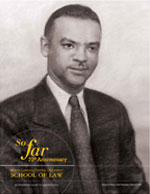 The North Carolina General Assembly enacted House Bill 18 on March 1, 1939, paving the way for a new generation of black lawyers in North Carolina. The bill, authorizing a law school at North Carolina College for Negroes, (now North Carolina Central University) was passed 25 years after Shaw University, in Raleigh, N.C., closed its law school in 1914, a move that left no in-state option for blacks to receive a formal education in law. Following the Great Depression, the legislation was, in theory, a way to create a separate-but-equal option for blacks who wanted to become lawyers, without integrating the law school at the University of North Carolina at Chapel Hill.
The North Carolina General Assembly enacted House Bill 18 on March 1, 1939, paving the way for a new generation of black lawyers in North Carolina. The bill, authorizing a law school at North Carolina College for Negroes, (now North Carolina Central University) was passed 25 years after Shaw University, in Raleigh, N.C., closed its law school in 1914, a move that left no in-state option for blacks to receive a formal education in law. Following the Great Depression, the legislation was, in theory, a way to create a separate-but-equal option for blacks who wanted to become lawyers, without integrating the law school at the University of North Carolina at Chapel Hill.
House Bill 18 authorized the Board of Trustees to establish the North Carolina College for Negroes Law School and announced it would open in the fall of 1939. Due to the amount of time the college had to prepare and advertise the law school, only one student registered, resulting in the administration delaying the opening to the following year. Law School Dean Maurice T. Van Hecke, who was also dean of the University of North Carolina at Chapel Hill (UNC-CH) law school, solicited advice and opinions about the school’s curriculum from black attorneys and others. In December 1939, Durham Attorney C. Jerry Gates thanked Van Hecke for providing him with a copy of the law school’s bulletin. He also wrote:
“I am profoundly of the opinion that the legal education of the Negro in the South has been grossly neglected … The lawyer, in America, comes within the class of the accepted leaders of his people, and if the Negro is to keep pace with his fellow white citizens, he must develop within his ranks strong, competent and outstanding lawyers.”
Gates’ letter went on to express his disappointment that the Law School had no blacks on the faculty. “Having even a part-time Black on the faculty," he argued, “would have gone a long way in disabusing the average Negro’s mind of the popular notion that the Negro can’t serve in such capacity and to a great extent that he is prohibited from practicing law in the south as the white lawyer does.” “I am aware of the fact that a conscientious effort was made to secure some qualified Negro to act in this capacity,” he continued. “However, I can’t help but regret that such an effort was not successful.”
Also in December 1939, Winston-Salem Attorney W. Avery Jones wrote Van Hecke that the curriculum outlined in the bulletin “meets with my approval in every way.” “There is one suggestion that I should like to make relative to the colored law school,” he continued.
“In view of the fact that there are so few law offices into which the graduates may enter and gain practical experience after graduation and admission to the Bar, it is very necessary that these students be given as much practical training in the law school as possible. It is one thing to know the principles of law involved and what ought to be done; but, an entirely different thing to know how to do it. I, therefore, suggest that the students be given practical training in drawing all kinds of papers so that they will be somewhat self-reliant when they enter the field.”
 To read more about the history of NCCU School of Law, download the Fall 2009 issue of So Far or explore the History and Scholarship Link to Digital Archives (https://archives.law.nccu.edu).
To read more about the history of NCCU School of Law, download the Fall 2009 issue of So Far or explore the History and Scholarship Link to Digital Archives (https://archives.law.nccu.edu).